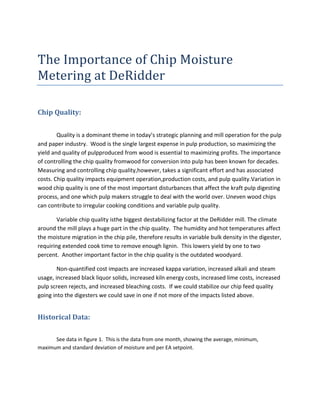
The importance of chip moisture metering at de ridder
- 1. The Importance of Chip Moisture Metering at DeRidder Chip Quality: Quality is a dominant theme in today’s strategic planning and mill operation for the pulp and paper industry. Wood is the single largest expense in pulp production, so maximizing the yield and quality of pulpproduced from wood is essential to maximizing profits. The importance of controlling the chip quality fromwood for conversion into pulp has been known for decades. Measuring and controlling chip quality,however, takes a significant effort and has associated costs. Chip quality impacts equipment operation,production costs, and pulp quality.Variation in wood chip quality is one of the most important disturbances that affect the kraft pulp digesting process, and one which pulp makers struggle to deal with the world over. Uneven wood chips can contribute to irregular cooking conditions and variable pulp quality. Variable chip quality isthe biggest destabilizing factor at the DeRidder mill. The climate around the mill plays a huge part in the chip quality. The humidity and hot temperatures affect the moisture migration in the chip pile, therefore results in variable bulk density in the digester, requiring extended cook time to remove enough lignin. This lowers yield by one to two percent. Another important factor in the chip quality is the outdated woodyard. Non-quantified cost impacts are increased kappa variation, increased alkali and steam usage, increased black liquor solids, increased kiln energy costs, increased lime costs, increased pulp screen rejects, and increased bleaching costs. If we could stabilize our chip feed quality going into the digesters we could save in one if not more of the impacts listed above. Historical Data: See data in figure 1. This is the data from one month, showing the average, minimum, maximum and standard deviation of moisture and per EA setpoint.
- 2. Monthly Data Average Min Max St Dev Moisture 48.5 42.6 54.7 1.79 Per EA SP 11.1 10.5 11.8 0.30 Figure 1: Monthly Moisture Data Data in figure 2 shows the actual average moisture for the month, along with the gallons of liquor, the liquor versus wood ratio, and per EA. Acutal Average Moisture 35.5 OD tons chips per digester 26,248 gallons of liquor (WL, BL, and Chip moisture) 0.37 liq/wood ratio 10.8 Per EA Figure 2: Actual Average Moisture Data Over all the chips fed into the digester are of decent quality; however the center of the chips might not completely cook, thus affecting the percent yield. Data in figure 3 shows the minumim moisture for the month, along with the gallons of liquor, the liquor versus wood ratio, and per EA. Minimum Moisture 39.6 OD tons chips per digester 25,279 gallons of liquor (WL, BL, and Chip moisture) 0.32 liq/wood ratio 9.7 Per EA Figure 3: Minimum Moisture Data As you can see from this data, there is a low liquor to wood ratio. The digester doesn’t roll over and we have to cut chip tons. There is also a low per EA, which cooks the outside of chip well however leaving its center hard. Since the center of the wood chip does not separate, could give false low kappa test. This causes operators to increase kappa, resulting in overuse of chemical and wasted money.The amps on equipment would also be increased resulting in energy loss. Data in figure 4 shows the maximum moisture for the month, along with the gallons of liquor, the liquor versus wood ratio, and per EA.
- 3. Maximum Moisture 31.3 OD tons chips per digester 27,272 gallons of liquor (WL, BL, and Chip moisture) 0.44 liq/wood ratio 12.3 Per EA Figure 3: Minimum Moisture Data As you can see from the data above, there is high liquor to wood ratio, and the digester produced fewer tons of pulp. There is also a high per EA, resulting in a low kappa. In month this data was collected, 185 base digesters were 0.3%+ EA higher than the setpoint. Assuming this yield,the lower kappa, this is a potential loss of $3.7k for the month. This is assuming one dollar per ton. In April, 274 base digesterwere 0.3%+ EA higher than setpoint. Assuming this yield, this is potential loss of $5.7k for the month. (Also assuming one dollar per ton.) Last year’s total was about2500 digesters that were 0.3%+ EA higher than setpoint. Assuming this yield, this is potential loss of $50.2 k. Based on cost information from 2006, the existing upgrade for the Moist Scan was $36,720. The Moist Scan unit has never operated properly, we have had several service representatives come out to troubleshoot it. What I have gathered from the last visit is the employee that came out and calibrated it is no longer employed with the company and no one else knows what he did. The more they come out to troubleshoot the unit the worse it gets. The unit we currently have is no longer in operating condition and its very outdated. We realize Moist Scan may be the preferred supplier for these units, however, our experience with their customer service has been horrible to say the least.